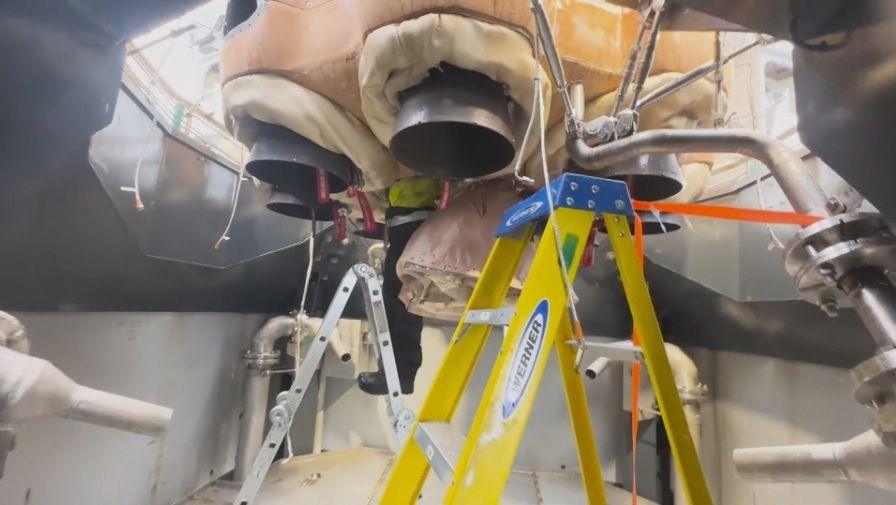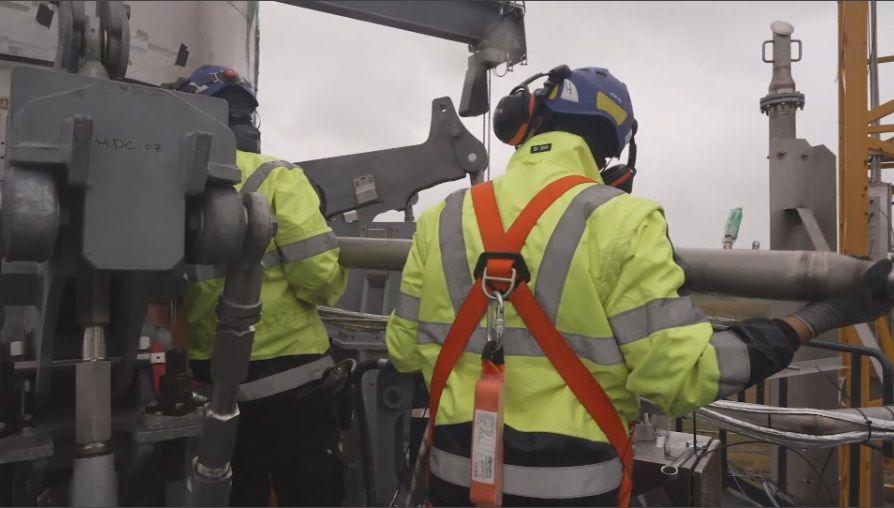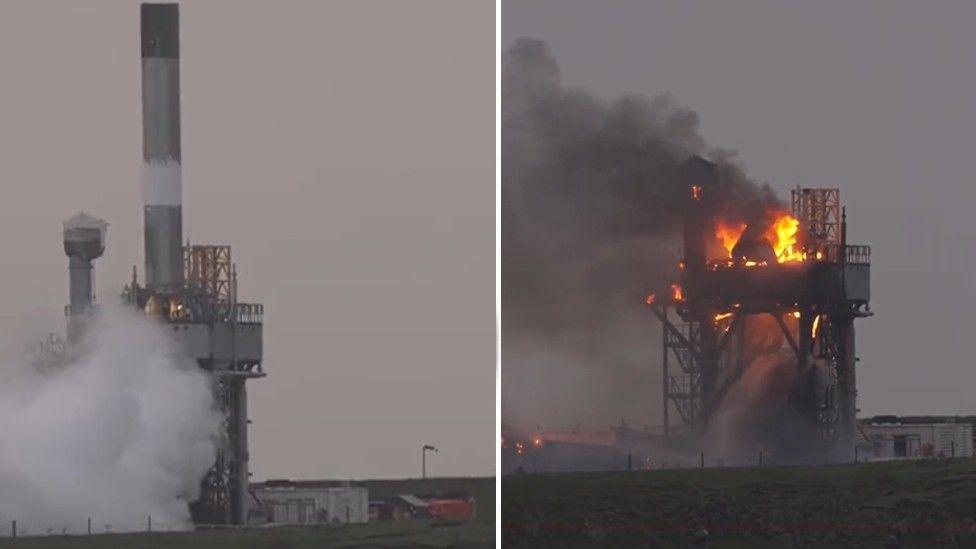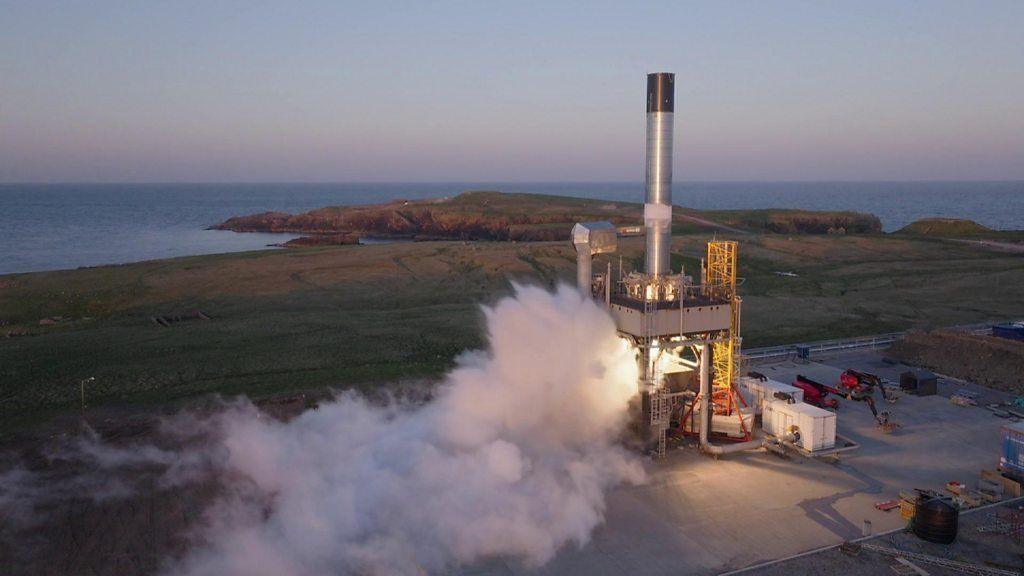'Rocket flames began shooting sideways then the sound wave hit'
Moment rocket engine explodes during launch test in Shetland
- Published
We were in Shetland to film the latest developments in the UK's space race when the rocket launch pad caught fire so dramatically.
Our BBC crew was a safe distance across a bay, around a mile away from the rocket's launch pad at SaxaVord spaceport on Unst when the explosion happened on Monday evening.
The 30-second “hot fire test” intended to replicate the downward thrust required to get a rocket into space - without anything actually taking off.
But it was immediately clear the test had not gone according to plan.
Moment rocket engine explodes in Shetland
- Published19 August 2024
Rocket engine explodes during test at Shetland spaceport
- Published19 August 2024
The team behind the launch is now trying to work out what went wrong with the ground-based engine firing.
Unst is Britain’s most northerly inhabited island. When it comes to the issue of safety around any rocket testing and eventual firing, its remoteness is part of the attraction.
Several rocket companies vying to take satellites into space have already tested engines at their site.
The spaceport has a licence to enable them to carry out up to 30 launches a year.
BBC News had exclusive access to the launch site to witness German rocket company Rocket Factory Augsburg (RFA) prepare for what should have been one of the final milestones before a first test flight planned for the end of the year.
The RFA One is a 30m-tall, three-stage rocket that can deliver a 1,300kg payload to a sun-synchronous orbit around Earth.
RFA wants to use its rockets to launch satellites into orbit, catering to a growing global demand for space launches.
It hopes to be the first company to launch vertical rockets into orbit from UK soil.
SaxaVord Spaceport said all safety protocols were observed and, as is procedure, the site was evacuated prior to Monday's test, leaving no staff at risk.

BBC News filmed preparations on the engine platform before the failed launch test
As evening drew in, heavy showers which had been sweeping across the island briefly eased, making it easier to observe the test from our distant vantage point.
There were signs the test was imminent: frost appearing on the rocket stage, white clouds billowing from beneath the engine.
At any point before ignition the team monitoring the system could abort the test, even with just seconds to go.
All seemed to be going to plan as the test got under way, until flames began shooting sideways from the engine platform, rather than being directed down.
The sound wave hit us a second or two after the engines appeared to ignite.
Sparks flew in all directions as the launch tower was engulfed in flames.
Loud bangs were accompanied by dark, fiery clouds of smoke, twisting upwards as the flames took hold on the platform where we had earlier watched engineers meticulously prepare for this moment.

RFA was trying to ignite nine helix engines simultaneously
Jonas Kellner from RFA had earlier explained to me what the company was hoping to do.
The purpose of the test was, he said, was to ignite all nine helix engines simultaneously, make sure they ran in a stable manner and then shut them off in safe and controlled manner.
Getting all nine engines to fire simultaneously is complicated.
According to Malcolm Macdonald, Professor of Applied Space Technology at the University of Strathclyde, “space is difficult and rockets are even harder”.
He said one of the challenges when firing multiple engines on the same launch vehicle is to get them firing at the same time, working as a pack.
“They’re all vibrating,” he added, “so getting them all to behave correctly and to perform optimally is a real challenge because of the interference of one rocket engine to the next."
Testing and subsequent launches can be fraught with difficulty.
The first UK satellite mission launch was from Cornwall at the beginning of 2023.
It ended when the Virgin Orbit jumbo jet lost the rocket it released horizontally after it suffered an anomaly.
Last year a SpaceX starship spacecraft exploded minutes after lift off.
Afterwards, Elon Musk congratulated his team on what he called an “exciting launch” and said they had learned a lot.

Before and after the launch explosion at the Unst spaceport
The first stage of RFA's 30-metre long rocket test had been impressive.
As we walked around the launch vehicle ahead of what was ultimately an unsuccessful firing, what also stood out to me was the relative youth of this highly skilled workforce of rocket scientists, engineers and technicians.
The average age here is 29. I’m told this is not unusual for companies developing rockets.
The team in Unst and others back at the company's headquarters in Germany will now start studying the pictures from the cameras they had placed around the site and analysing the huge amount of data they have gathered, trying to work out what caused the fire.
In a statement, RFA said they were aware of the higher risk attached to their "iterative approach" and that they will take their time “to assess the situation" and that their goal was to "return to regular operations as soon as possible”.
Setting vertical rockets into space is hard.
The hot fire test in Unst demonstrated both why these tests are important and how challenging launching rockets can be.
- Published22 May 2024

- Published1 August 2023
